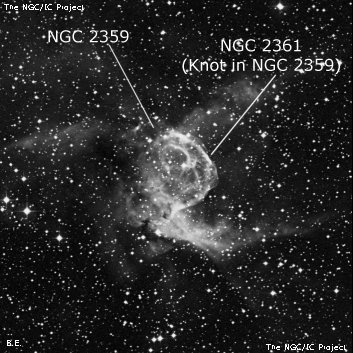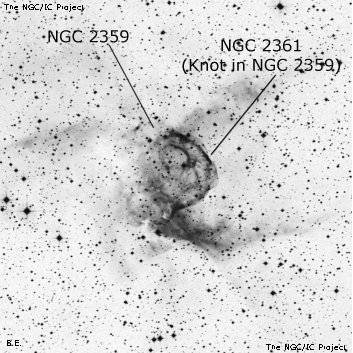NGC/IC Project Restoration Effort
(This is a very very beta version)
NGC2359


Basic Information
Location and Magnitude
Right Ascension: 7:18:30.0
Declination: -13:13:30
Constellation: CMA
Visual Magnitude:
Historic Information
Discoverer: Herschel W.
Year of discovery: 1785
Discovery aperture: 18.7
Observational
Summary description: !!, vF, vvL, viF
Sub-type: EN
Corwin's Notes
=====
NGC 2359. JH's description and sketch from his Cape Observations is very
appropriate for this large object:
A very singular nebula, much like the profile of a bust (head, neck, and
shoulders) or a silhouette portrait; very large, pretty well-defined, light
nearly uniform, about 12' diameter. In a crowded field of Milky Way stars,
many of which are projected on it. See figure 4, Plate IV [in CGH].
However, his position is 1 minute of time too far west. WH's RA is OK, but
his Dec is too far north by about 7 arcmin, roughly the size of the nebula.
Both JH and Dreyer, of course, trusted JH's CGH positions, so the GC and NGC
are correct in Dec but off in RA. Neither catalogue has a note about the
one minute of time difference, so it was left to Herbert Howe to rediscover
the error. He mentioned it twice in his Monthly Notices papers (58, 515, 1898
and 61, 29, 1900), bringing it to Dreyer's attention. Dreyer finally corrects
the RA in a note in IC2, mentioning there that WH's RA is good.
Howe also has some speculation about the relationship of NGC 2361 (which see)
to NGC 2359 based on the one minute of time error. This may indeed as Howe
suggests have played a role in Bigourdan's observations, but Howe's remarks
led Dreyer to suggest that 2361 may be identical to H V 21, which it is not.
What Dreyer apparently had in mind was that h 3075 and H V 21 are different
objects, but they are, in fact, one and the same.
Steve's Notes
=====
NGC 2359
48" (4/13/10): the 5' central region of Thor's Helmet was mesmerizing at 267x and 330x (unfiltered). A large, bright knot is at the south end of the rim where the inner portion of the bright wing that heads southwest connects with the central bubble. Along the northern edge of the rim are three collinear mag 11 stars (2.2' length) oriented E-W. The rim of the bubble is noticeably brighter in a thin arc beginning due north of center (between the two western stars) and extending about 90¡ clockwise to the west (this portion of Thor's Helmet was catalogued separately as NGC 2361). The rim is also brighter along a 45¡ thicker arc on the southeast side. The rim has a lower surface brightness on the east and NE side and varies in thickness and brightness around the entire bubble, enclosing a darker central region.
Three brighter stars (nearly collinear) and several fainter stars are superimposed within the main bubble. A second, smaller, incomplete bubble just north of center outlines an inner dark "hole", which includes one of the brighter stars. The 11.4-magnitude ionizing Wolf-Rayet star HD 56925 is at the southwest edge of this inner bubble. Additional thin wisps of nebulosity crisscross the central region.
17.5" (12/28/00): "Thor's Helmet" is a remarkably bright, detailed nebulosity at 100x using an OIII filter. The central region is a 5' bubble (illuminated by a Wolf-Rayet star) with a brighter rim along the west side giving a "C" appearance with irregular knots, filamentary wisps of nebulosity and areas of thinner nebulosity in the interior. A number of fainter stars are superimposed in the central region along with some brighter mag 11 stars on the north portion of the rim. Attached at the south end is a brighter 4' extension elongated towards the west with a mag 9 star at its SE side. This section then thins out into a long 10' streamer that precedes the main section and forms the southern "horn" of the helmet. A second long, thicker streamer is attached at the north end of the central mass and extends out to the NW (this piece has been misidentified as IC 468). A fainter strip of nebulosity also begins on the north end and extends 10' due east while weak nebulosity is also east of the central helmet off the south side. Illuminated by the Wolf-Rayet star HD 56925 = WR 7.
13" (1/28/84): unusual emission nebula, fairly bright, fairly large, about 7'x5'. A thinner section elongated at a right angle (E-W) extends west of a mag 10 star on the south end. A few fainter stars are superimposed on the north side. A very faint section is attached at the NW end extending towards the NW.
13x80mm (1/13/07): the circular central region of Thor's Helmet was easily visible at 13x in my 80mm finder using an OIII filter (24mm Panoptic), though the "horns" of the helmet were not seen.



